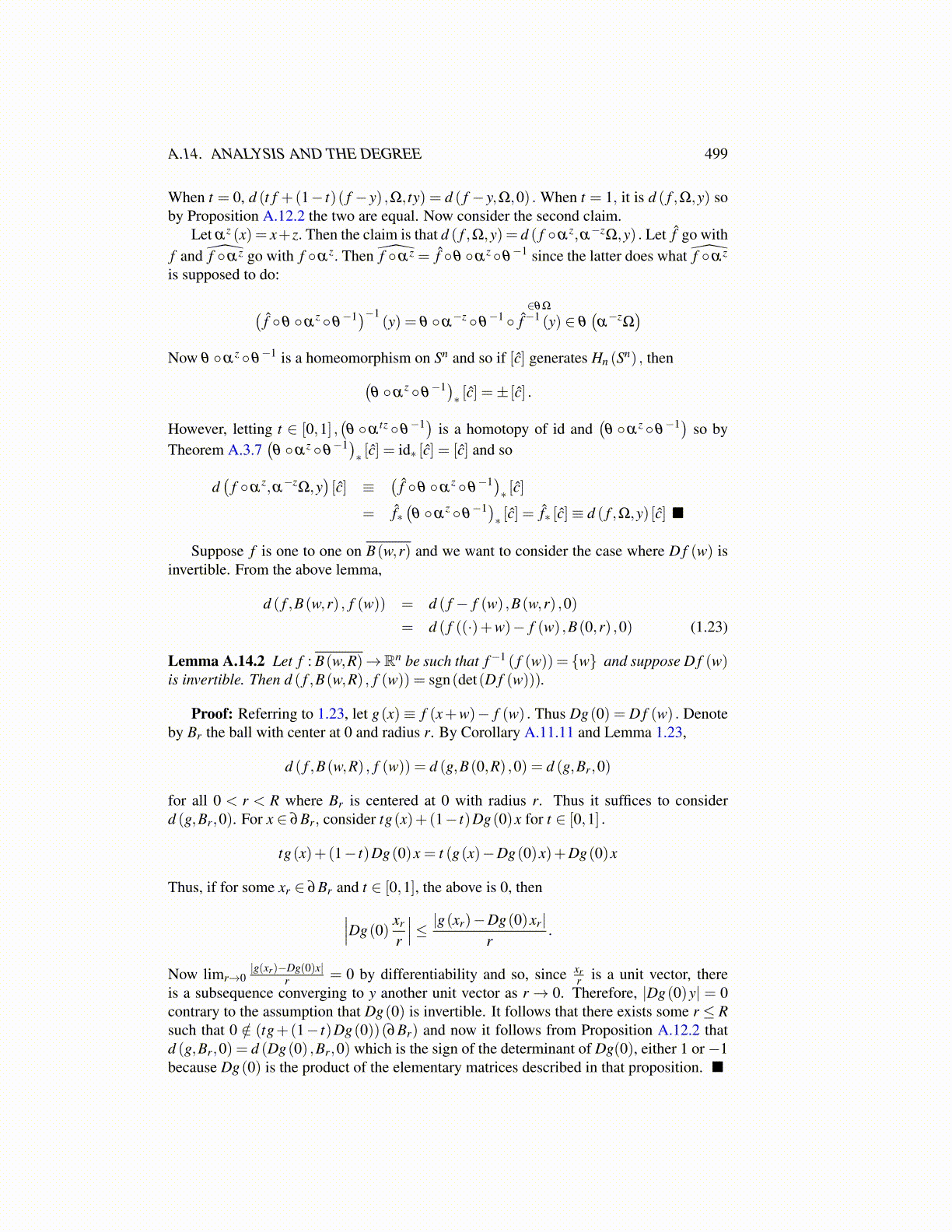
A.14. ANALYSIS AND THE DEGREE 499
When t = 0, d (t f +(1− t)( f − y) ,Ω, ty) = d ( f − y,Ω,0) . When t = 1, it is d ( f ,Ω,y) soby Proposition A.12.2 the two are equal. Now consider the second claim.
Let αz (x) = x+z. Then the claim is that d ( f ,Ω,y) = d ( f ◦αz,α−zΩ,y) . Let f̂ go withf and f̂ ◦αz go with f ◦αz. Then f̂ ◦αz = f̂ ◦θ ◦αz ◦θ
−1 since the latter does what f̂ ◦αz
is supposed to do:
(f̂ ◦θ ◦α
z ◦θ−1)−1
(y) = θ ◦α−z ◦θ
−1 ◦∈θΩ
f̂−1 (y) ∈ θ(α−z
Ω)
Now θ ◦αz ◦θ−1 is a homeomorphism on Sn and so if [ĉ] generates Hn (Sn) , then(
θ ◦αz ◦θ
−1)∗ [ĉ] =± [ĉ] .
However, letting t ∈ [0,1] ,(θ ◦α tz ◦θ
−1) is a homotopy of id and(θ ◦αz ◦θ
−1) so byTheorem A.3.7
(θ ◦αz ◦θ
−1)∗ [ĉ] = id∗ [ĉ] = [ĉ] and so
d(
f ◦αz,α−z
Ω,y)[ĉ] ≡
(f̂ ◦θ ◦α
z ◦θ−1)∗ [ĉ]
= f̂∗(θ ◦α
z ◦θ−1)∗ [ĉ] = f̂∗ [ĉ]≡ d ( f ,Ω,y) [ĉ] ■
Suppose f is one to one on B(w,r) and we want to consider the case where D f (w) isinvertible. From the above lemma,
d ( f ,B(w,r) , f (w)) = d ( f − f (w) ,B(w,r) ,0)= d ( f ((·)+w)− f (w) ,B(0,r) ,0) (1.23)
Lemma A.14.2 Let f : B(w,R)→Rn be such that f−1 ( f (w)) = {w} and suppose D f (w)is invertible. Then d ( f ,B(w,R) , f (w)) = sgn(det(D f (w))).
Proof: Referring to 1.23, let g(x)≡ f (x+w)− f (w) . Thus Dg(0) = D f (w) . Denoteby Br the ball with center at 0 and radius r. By Corollary A.11.11 and Lemma 1.23,
d ( f ,B(w,R) , f (w)) = d (g,B(0,R) ,0) = d (g,Br,0)
for all 0 < r < R where Br is centered at 0 with radius r. Thus it suffices to considerd (g,Br,0). For x ∈ ∂Br, consider tg(x)+(1− t)Dg(0)x for t ∈ [0,1] .
tg(x)+(1− t)Dg(0)x = t (g(x)−Dg(0)x)+Dg(0)x
Thus, if for some xr ∈ ∂Br and t ∈ [0,1], the above is 0, then∣∣∣Dg(0)xr
r
∣∣∣≤ |g(xr)−Dg(0)xr|r
.
Now limr→0|g(xr)−Dg(0)x|
r = 0 by differentiability and so, since xrr is a unit vector, there
is a subsequence converging to y another unit vector as r→ 0. Therefore, |Dg(0)y| = 0contrary to the assumption that Dg(0) is invertible. It follows that there exists some r ≤ Rsuch that 0 /∈ (tg+(1− t)Dg(0))(∂Br) and now it follows from Proposition A.12.2 thatd (g,Br,0) = d (Dg(0) ,Br,0) which is the sign of the determinant of Dg(0), either 1 or −1because Dg(0) is the product of the elementary matrices described in that proposition. ■